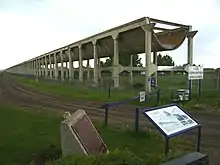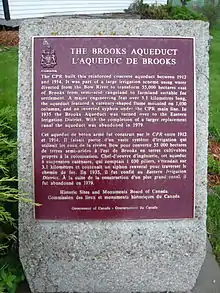Brooks Aqueduct
The Brooks Aqueduct is a defunct aqueduct, historic site and museum originally built by the irrigation division of the Canadian Pacific Railway Company during the early 1910's located in Southern Alberta, Canada. The aqueduct was intended to irrigate a section of southeastern Alberta by diverting water east from Lake Newell from 1914 to 1979, and is located approximately 8 kilometres south of the City of Brooks. The main section of the aqueduct spans a 3.2 km valley at an average elevation of 20 metres. The structure has been designated a National Historic Site with an interpretive centre constructed nearby for tourists.[1]
| Brooks Aqueduct | |
|---|---|
 | |
| Type | aqueduct |
| Location | Brooks, Alberta, Canada |
| Nearest city | County of Newell |
| Coordinates | 50.5289°N 111.8550°W |
| Built | 1912–1914 |
| Original use | Aqueduct |
| Governing body | Parks Canada |
| Website | Brooks Aqueduct |
| Official name | Brooks Aqueduct National Historic Site of Canada |
| Designated | 18 November 1983 |
| Official name | Brooks Aqueduct |
| Designated | 20 July 2000 |
 Location of Brooks Aqueduct in Alberta | |
History
The Brooks Aqueduct was conceived by the Canadian Pacific Railway as a mechanism to irrigate a portion of the Palliser's Triangle in southern Alberta. Canadian Pacific would receive a 3-million acre block of land between Calgary and Medicine Hat as a payment for the completion of the cross-Continental railway, which was divided into the Western, Central and Eastern sections.[2] The Eastern section of the land grant provided access to the Bow River and the reservoir at the Bassano Dam, which was fed to agricultural operations through a series of canals and irrigation projects built by Canadian Pacific.[3][4] Hugh B. Muckleston, the Assistant Chief Engineer for the Department of Natural Resources for Canadian Pacific was the first to envision to Brooks Aqueduct, noting an earthen filled canal would be inconceivable given the terrain conditions.[5] The decision was made to use reinforced Portland Cement[6] with an open flume designed as a hydrostatic catenary curve.[7] The design also incorporated expansion joints to allow for movement along the long aqueduct due to expansion and contraction with varying temperatures, the joints were made primarily of copper. The expansion joints were placed every 24-metres (80 feet) or fourth bent.[8] In order to cross the Canadian Pacific Railway Main Line, a siphon was built which operated based on the Venturi principle approximately 40 feet under the railway tracks.[9]
The firm of Grant, Smith & Co. & McDonnell of Vancouver was contracted to construct the Brooks Aqueduct between 1912-1914.[10] At its completion in 1914, and beginning of operations in 1915 the CA$700,000,[11] Brooks Aqueduct claimed to be the largest concrete structure in existence.[12][13] The copper expansion joints had significant leaks following construction which caused damage to the concrete supports, this was mitigated by drainage ditches and efforts to reduce the leakage, furthermore the alkalinity of the water conveyed, combined with frost accumulation caused unavoidable deterioration to the concrete structure. Canadian Pacific would continue to refurbish the aqueduct through the 1920s and early 1930s, spraying gunnite over the rotting pedestals and flaking concrete shells.[14] Following the completion of these upgrades in 1934 the Brooks Aqueduct was transferred to the Eastern Irrigation District, a farmer-owned entity formed under the Irrigation Districts Act in 1935, this was part of a larger divestment in the region by Canadian Pacific.[12][15] The aqueduct was used for irrigation for about 30 years. Its original capacity was 900 cubic feet per second (25 m3/s).[16] and the 113,000 hectares of land which were provided with water led to a new wave of settlement.[17]
In 1969, the Alberta and Canadian governments assumed the responsibility of maintaining the structure under the Prairie Farm Rehabilitation Administration. The Brooks Aqueduct and Bassano Dam were evaluated, and it was found that the Dam would require minor rehabilitation, while the Aqueduct was no longer suitable for operations. A series of earthen canals were constructed as a replacement for the aqueduct, and after evaluating the cost of demolishing the structure, the governments decided it would be more financially prudent to fenced the aqueduct off from the public.[18]
Legacy
The Brooks Aqueduct continues to stand to this day, although the structure itself is no longer structurally sound and has been fenced off since the 1970s. The Brooks Aqueduct and the immediate surrounding area was designated a National Historic Site of Canada on 18 November 1983 by the Government of Canada.[1][19] The Brooks Aqueduct would later be designated a Provincial Historical Resource by the Government of Alberta on 20 July 2000.[15]

References
- Jayne Seagrave (30 April 2015). Camping with Kids in the West: BC and Alberta's Best Family Campgrounds. Heritage House. p. 159. ISBN 978-1-77203-041-9.
- "Canadian Pacific Railway". The Official Brooks Aqueduct Home Page. Retrieved 5 August 2020.
- Ted Stone (1996). Alberta History Along the Highway: A Traveler's Guide to the Fascinating Facts, Intriguing Incidents and Lively Legends in Alberta's Past. Red Deer College Press. p. 79. ISBN 978-0-88995-133-4.
- "The Eastern Section". The Official Brooks Aqueduct Home Page. Retrieved 5 August 2020.
- "Introduction to the Brooks Aqueduct". The Official Brooks Aqueduct Home Page. Retrieved 5 August 2020.
- Engineering News. 77. G.H. Frost. 1917. p. 469.
- "Flume Design". The Official Brooks Aqueduct Home Page. Retrieved 5 August 2020.
- "Expansion Joints". The Official Brooks Aqueduct Home Page. Retrieved 5 August 2020.
- "Siphon Design". The Official Brooks Aqueduct Home Page. Retrieved 5 August 2020.
- "Construction". The Official Brooks Aqueduct Home Page. Retrieved 5 August 2020.
- "Brooks Aqueduct". Alberta Heritage Survey Program. Government of Alberta. Retrieved 4 August 2020.
- Ron Brown (30 June 2012). Rails Across the Prairies: The Railway Heritage of Canada's Prairie Provinces. Dundurn. p. 22. ISBN 978-1-4597-0216-5.
- The Interpreter. Western Interpreters Association. 1979. pp. 19–20.
- "Maintenance". The Official Brooks Aqueduct Home Page. Retrieved 5 August 2020.
- Brooks Aqueduct. Canadian Register of Historic Places. Retrieved August 4, 2020.
- Engineering Works of Calgary. 1915. p. 16. Archived from the original on 2015-09-24. Retrieved 2013-08-01.
- Ron Brown (8 August 2015). Dundurn Railroad 5-Book Bundle: In Search of the Grand Trunk / Rails Across the Prairies / Rails Across Ontario / The Train Doesn't Stop Here Anymore / Rails to the Atlantic. Dundurn. p. 699. ISBN 978-1-4597-3303-9.
- "The Fate of the Brooks Aqueduct". The Official Brooks Aqueduct Home Page. Retrieved 5 August 2020.
- Brooks Aqueduct National Historic Site of Canada. Canadian Register of Historic Places. Retrieved August 4, 2020.
External links
| Wikimedia Commons has media related to Brooks Aqueduct. |
- Brooks Aqueduct Official Website
- Brooks Aqueduct. Canadian Register of Historic Places. (Provincial Historical Designation)
- Brooks Aqueduct National Historic Site of Canada. Canadian Register of Historic Places. (Federal Historical Designation)
- Brooks Aqueduct Alberta Community Development Historic Sites and Archive Service
- Brooks Aqueduct National Historic Site of Canada at Parks Canada
- "Brooks Aqueduct". The Canadian Encyclopedia

